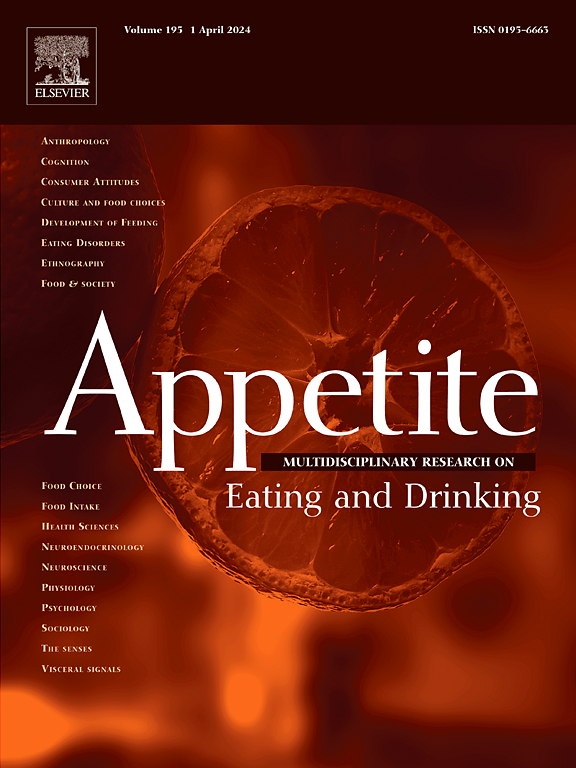Behavioral separation of liking and wanting in response to olfactory and visual food cues
IF 4.6
2区 医学
Q1 BEHAVIORAL SCIENCES
引用次数: 0
Abstract
In real-world settings, food rewards are processed in parallel across several sensory modalities, but paradigms that compare contributions of different modalities are lacking. While odor perception in particular is frequently implicated in appetite regulation, the mechanisms by which food odors differentially evoke experiences of wanting and liking remain poorly understood. This study addressed this gap by dissociating liking from wanting responses for olfactory stimuli, and establishing commonalities and differences relative to the visual modality. In two separate experiments, participants (n1 = 37, n2 = 43) rated content-matched batteries of odors and pictures, respectively, for their ability to elicit pleasure (liking) and desire to eat (wanting). A third experiment (n3 = 39) utilized a combined olfactory-visual paradigm to test the separation of these dimensions in a multisensory context. Our results show that participants differentiated clearly and reliably between liking and wanting for both odors and pictures, as demonstrated by a high difference score between the two in non-food (high liking, low wanting), but not in food (both high) or disgusting stimuli (both low), and high within-session retest reliability. Higher variability for olfactory relative to visual assessments was observed and likely reflects well-established difficulties with odor object identification. Taken together, our study demonstrates that olfactory stimuli can be used in experimental settings to evoke separable experiences of liking and wanting for food and non-food stimuli. Manipulating these components independently across sensory modalities in experimental studies could generate novel insights into how olfactory and visual cues differentially contribute to anticipatory and consummatory food reward processing, in healthy and disordered eating.
在嗅觉和视觉食物线索的作用下,行为上将 "喜欢 "和 "想要 "分开。
在现实世界中,食物奖励是通过几种感官模式并行处理的,但缺乏比较不同模式贡献的范例。虽然气味感知经常与食欲调节有关,但人们对食物气味唤起想要和喜欢的不同体验的机制仍然知之甚少。本研究通过将嗅觉刺激的 "喜欢 "和 "想要 "反应区分开来,并确定与视觉模式的共性和差异,填补了这一空白。在两个独立的实验中,参与者(n1=37,n2=43)分别对内容匹配的气味和图片进行评分,看它们是否能引起愉悦感(喜欢)和进食欲望(想要)。第三个实验(n3=39)采用了嗅觉和视觉相结合的范式,以测试在多感官情境下这些维度的分离情况。我们的结果表明,被试对气味和图片的 "喜欢 "和 "想要 "都有明确而可靠的区分,这表现在对非食物刺激("喜欢 "高,"想要 "低),而对食物刺激("喜欢 "和 "想要 "都高)或恶心刺激("恶心 "和 "想要 "都低),两者之间的差异分值都很高,而且被试在测试期间的重测可靠性也很高。与视觉评估相比,嗅觉评估的变异性更高,这很可能反映了气味对象识别方面的公认困难。综上所述,我们的研究表明,嗅觉刺激可以在实验环境中用于唤起对食物和非食物刺激的可分离的喜欢和渴望体验。在实验研究中跨感官模式独立操纵这些成分,可以让我们对健康饮食和饮食失调中嗅觉和视觉线索是如何对预期性和消耗性食物奖赏处理做出不同贡献产生新的认识。
本文章由计算机程序翻译,如有差异,请以英文原文为准。
求助全文
约1分钟内获得全文
求助全文
来源期刊

Appetite
医学-行为科学
CiteScore
9.10
自引率
11.10%
发文量
566
审稿时长
13.4 weeks
期刊介绍:
Appetite is an international research journal specializing in cultural, social, psychological, sensory and physiological influences on the selection and intake of foods and drinks. It covers normal and disordered eating and drinking and welcomes studies of both human and non-human animal behaviour toward food. Appetite publishes research reports, reviews and commentaries. Thematic special issues appear regularly. From time to time the journal carries abstracts from professional meetings. Submissions to Appetite are expected to be based primarily on observations directly related to the selection and intake of foods and drinks; papers that are primarily focused on topics such as nutrition or obesity will not be considered unless they specifically make a novel scientific contribution to the understanding of appetite in line with the journal's aims and scope.
 求助内容:
求助内容: 应助结果提醒方式:
应助结果提醒方式:


